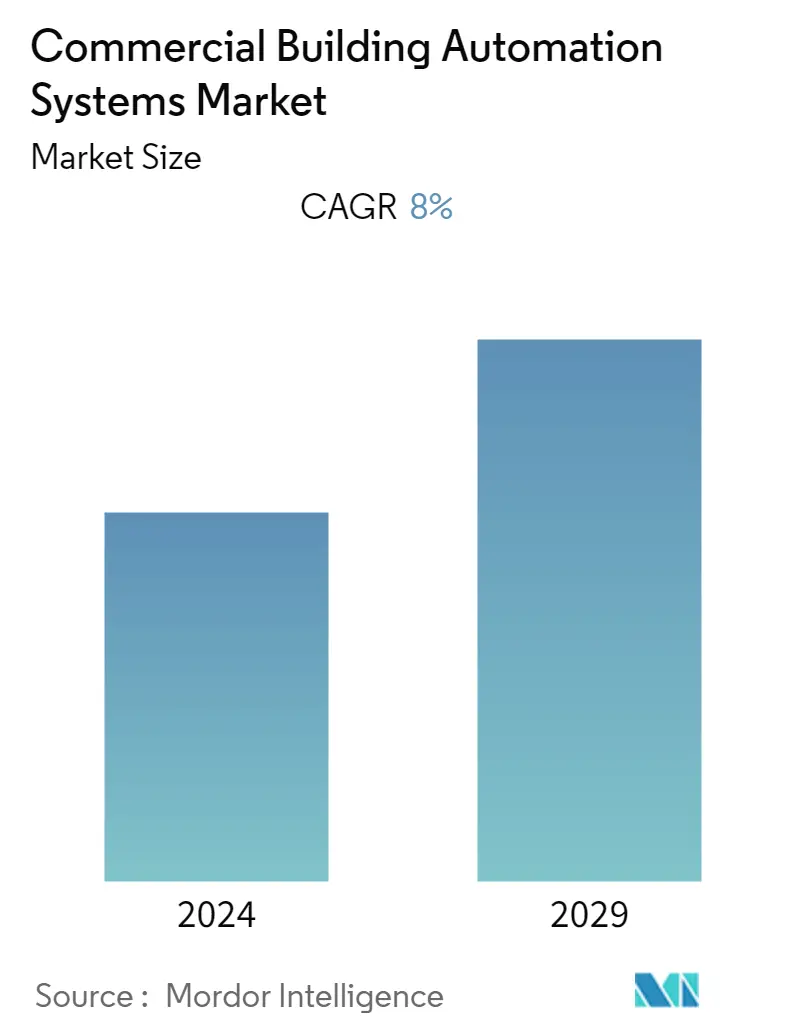Market Size of Commercial Building Automation Systems Industry

| Study Period | 2019 - 2029 |
| Base Year For Estimation | 2023 |
| CAGR | 8.00 % |
| Fastest Growing Market | Asia Pacific |
| Largest Market | North America |
| Market Concentration | Low |
Major Players/commercial-building-automation-systems-market---growth,-trends,-and-forecast-(2020---2025)_Picture38.webp)
*Disclaimer: Major Players sorted in no particular order |
Commercial Building Automation Market Analysis
The commercial building automation systems market is expected to grow at a CAGR of 8% over the forecast period (2021-2026). Government endeavors for developing green buildings and a rise in green building development by a few distinct organizations are the key points driving the market studied. Green buildings are developed using reused squander assets from development destinations. Expanded interest for green building materials was seen in private buildings and offices, as well as in commercial buildings sections.
- The market studied continues to have a solid performance due to several dynamic forces, such as a potential trade war, skilled talent shortages, and straining supply chains. Commercial building automation provides service in lighting control and regulation, blind and shutter control, energy and load management, security and fault monitoring, and temperature control and regulation.
- A growing number of commercial building construction activities, increasing demand for lowering operating costs in construction, and rising demand for comfort and satisfaction are expected to drive the market studied. Building automation has been around for many decades. However, due to factors, like energy conservation and mandates for green construction, new technologies have been introduced. The latest smart building solutions leverage new technologies, such as IoT, Big Data, cloud computing, data analytics, deep learning, and artificial intelligence, for the benefits of saving energy, reducing operational expenditures, increasing occupancy comfort, and meeting increasingly stringent global regulations and sustainability standards. For example, Aquicore, a performance management platform of real estate, recently launched a new energy optimization tool named 'optimal start time'. This tool uses a complex algorithm in factoring outdoor temperature, insulation levels, and equipment efficiency. Optimal start time enables buildings to quickly save operating costs without affecting the tenant's comfort. Moreover, the growing need for eco-friendly products may positively impact the commercial building automation market.
Commercial Building Automation Industry Segmentation
This report aims to provide a detailed analysis of the commercial building automation systems market. It focuses on the market dynamics, emerging trends in the segments and regional markets, and insights on various product and application types. Furthermore, it analyses the key players and the competitive landscape in the market studied.
| By Product Type | |
| HVAC | |
| Building Management Systems | |
| Security and Access Control Systems | |
| Energy Management Systems | |
| Lighting Management Systems |
| By Application | |
| Multifamily | |
| Office | |
| Retail |
| By Geography | ||||||||
| ||||||||
| ||||||||
| ||||||||
| ||||||||
|
Commercial Building Automation Systems Market Size Summary
The commercial building automation market is experiencing robust growth, driven by the increasing emphasis on green building initiatives and the adoption of sustainable practices in construction. This market is characterized by the integration of advanced technologies such as IoT, Big Data, and artificial intelligence, which enhance energy efficiency, reduce operational costs, and improve occupant comfort. The demand for automation systems is fueled by the need to comply with stringent global regulations and sustainability standards, as well as the growing preference for eco-friendly products. These systems offer a range of services, including lighting control, energy management, and security monitoring, which are essential for modern commercial buildings aiming to optimize performance and reduce environmental impact.
The commercial real estate sector plays a crucial role in the economic landscape, with green building practices offering significant economic benefits such as lower operating expenses and higher occupancy rates. Government initiatives and corporate commitments to sustainability are key drivers of the market, encouraging the construction of eco-friendly commercial properties. Despite challenges like skilled labor shortages and supply chain issues, the market remains dynamic, with major players like GE, Honeywell, and Siemens continuously innovating and introducing new products. The fragmented nature of the market allows for diverse offerings, catering to the evolving needs of commercial building developers and investors seeking long-term value and sustainability in their projects.
Commercial Building Automation Systems Market Size - Table of Contents
-
1. MARKET DYNAMICS
-
1.1 Market Overview
-
1.2 Market Drivers
-
1.3 Market Restraints
-
1.4 Porters Five Forces Analysis
-
1.4.1 Threat of New Entrants
-
1.4.2 Bargaining Power of Buyers/Consumers
-
1.4.3 Bargaining Power of Suppliers
-
1.4.4 Threat of Substitute Products
-
1.4.5 Intensity of Competitive Rivalry
-
-
-
2. MARKET SEGMENTATION
-
2.1 By Product Type
-
2.1.1 HVAC
-
2.1.2 Building Management Systems
-
2.1.3 Security and Access Control Systems
-
2.1.4 Energy Management Systems
-
2.1.5 Lighting Management Systems
-
-
2.2 By Application
-
2.2.1 Multifamily
-
2.2.2 Office
-
2.2.3 Retail
-
-
2.3 By Geography
-
2.3.1 North America
-
2.3.1.1 United States
-
2.3.1.2 Canada
-
2.3.1.3 Mexico
-
2.3.1.4 Rest of North America
-
-
2.3.2 Europe
-
2.3.2.1 Germany
-
2.3.2.2 United Kingdom
-
2.3.2.3 France
-
2.3.2.4 Russia
-
2.3.2.5 Spain
-
2.3.2.6 Rest of Europe
-
-
2.3.3 Asia-Pacific
-
2.3.3.1 India
-
2.3.3.2 China
-
2.3.3.3 Japan
-
2.3.3.4 Rest of Asia-Pacific
-
-
2.3.4 South America
-
2.3.4.1 Brazil
-
2.3.4.2 Argentina
-
-
2.3.5 Middle East
-
2.3.5.1 United Arab Emirates
-
2.3.5.2 Saudi Arabia
-
2.3.5.3 Rest of Middle East
-
-
-
Commercial Building Automation Systems Market Size FAQs
What is the current Commercial Building Automation Systems Market size?
The Commercial Building Automation Systems Market is projected to register a CAGR of 8% during the forecast period (2024-2029)
Who are the key players in Commercial Building Automation Systems Market?
Siemens, Emerson, ABB, Schneider Electric and Rockwell Automation are the major companies operating in the Commercial Building Automation Systems Market.

